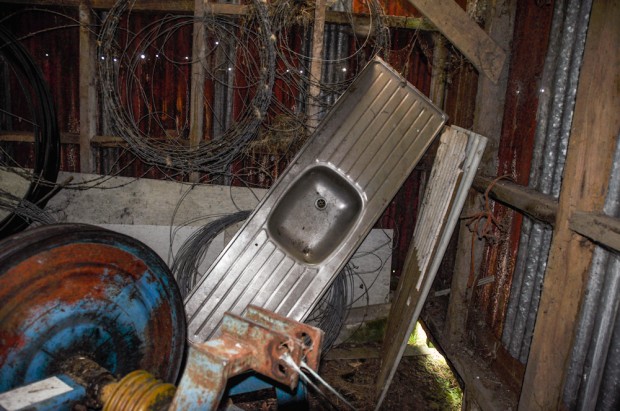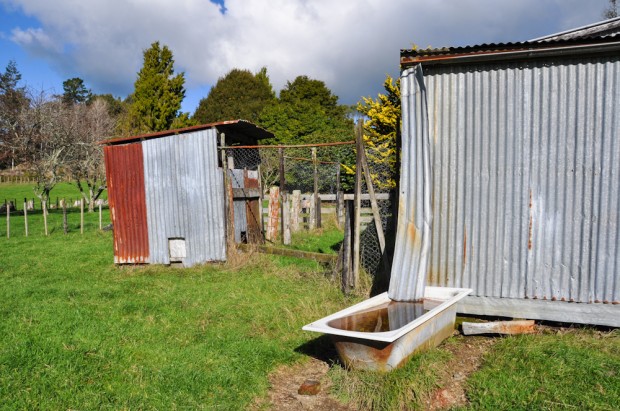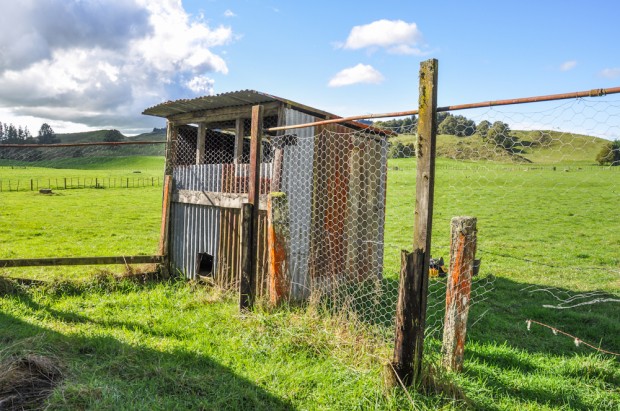A hundred-year-old working farm can be a messy place. As far as farms go we received ours in pretty good condition. The pastures have had a lot of love poured into them over the years (aka super-phosphate), are well drained and lush, and there are very few weeds. Working gravity-fed troughs are in all nine paddocks. It has mostly decent seven-wire around its two kilometre perimeter and the paddock fencing still has a few years left in it, too. So overall it’s top notch. But the outbuildings, however, have seen better days…

They’re looking a bit worse for wear and aren’t in ideal locations but it’s great that we have them and they do have a quintessential rural character that’s difficult to recreate with new materials. They’re charming in their own right. For the time being we’ll pretty them up a little and put them to good use, starting with a good clean out.
The previous owner left a bunch of stuff (not all junk) behind: Knickknacks, relics, and old mechanical components that are as rusty as they are mysterious. We don’t mind, as half of it is worth holding on to and will no doubt come in handy down the track (especially the timber). Last weekend we rummaged through the main shed and workshop. This weekend we dove into a couple of other adjacent sheds as well as an old chicken coop and run, which we may or may not repurpose (it’s pretty gnarly).


Weaving around the old hay bailer (which we had purchased from the farm’s previous owner), we fought through aeons of cobwebs to extract items like tyres, a kitchen sink, reels of barbed wire, piping, an old spring cot, eel traps, and an interesting little archaeological find…
An otherwise unremarkable slab of concrete happened to have retained some of the newspaper onto which it was poured. The newspaper – an issue of The New Zealand Herald – was like a timestamp, hinting at the era when the slab was made. I know, it’s no greenstone spearhead or ancient Maori bone carving, but given New Zealand’s relatively short history, a relic from even a few decades ago is still pretty fascinating.
A lot of the newspaper had rubbed off, but some of it was still legible. Unfortunately there were no dates to be found, but we did deduce that it’s at least forty to fifty years old, as goods are advertised in pounds rather than dollars and 1967 was the year that New Zealand decimalised its currency. I reckon the newspaper is at least another decade older than that, however, given the fashion depicted on one of the clothing advertisements. It may even be from the Wartime era, as there’s one excerpt without any company affiliation that recommends stocking up and conserving eggs – maybe part of a rationing campaign? Most revealing of how dated the artefact is was an advertising slogan that read “dandruff is dangerous!”


Some of the objects we’ve unearthed are probably much older than this – possibly a hundred years old from the original settlers of the area – but at least this piece has verifiable “antiquity”.
Satisfied that that particular shed was clean enough for the time being, we moved on to another which we discovered had a leaky roof. Without corrugated iron, the roof consists of wooden planks covered in plastic. The previous owner had nailed a big thick tarp (which was actually the side of a truck) to the beams from underneath. It had sort of worked, as many of these makeshift solutions do, but water had begun to pool in large amounts on top of the tarp, between it and the “roof”. At the bottom of the hanging bulges grew slimy beards of algae that dripped on you when you walked under them. It had to come down.
We pushed out the water bulges and set to work on a shaky ladder prying the heavy tarp from the beams. It’s tough work prying out nails above your head, especially when they’re damn roofing nails. Real buggers to get out. As with most tasks that seem simple at the outset, it took more time than expected.

Next we went around to inspect the chicken coop, which looked like it hadn’t seen a hen’s bum in a long time. The run had broken chunks of concrete swallowed by the grass which we had to dig out. We made use of the rugged iron pry bars we’d discovered when cleaning out the workshop the previous weekend. We pulled out some delicious old posts as well, which might make some nice rustic outdoor furniture.
Char managed to pull one of the posts out by hand, without any help from me or the aid of a pry bar. Born for it.

After clearing away some ragged chicken-wire and makeshift framing, the area looked a bit better. We did a quick job of clearing out inside the coop, too, which housed odds and ends. Just need to blast out all the hay and poop. We’re undecided on whether or not to reuse the coop as it’s quite shoddy. It’s also not in an ideal location and might be a bit too heavy to move. For now, at least it’s another place investigated and cleared that we can check off our list.



There are still some outbuildings which need a bit of attention, like the barn, but everything is starting to feel a bit more organised now with all the junk in one place: Our mounting trash pile.













